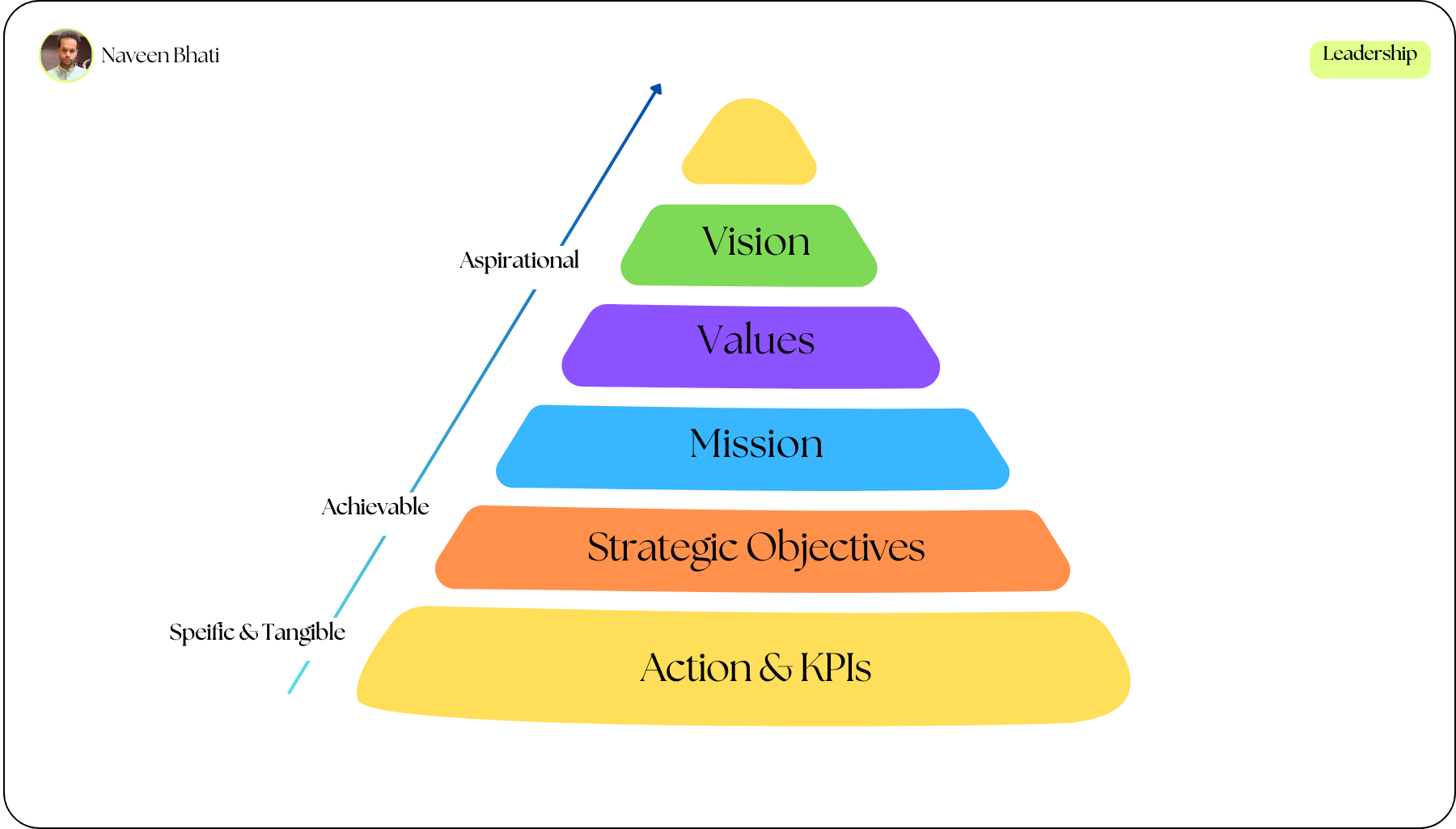Strategic Planning Pyramid
It's more important than ever to have a clear and concise plan for success. The Strategic Planning Pyramid is a powerful tool that can help you do just that.
This simple yet effective framework can be used by businesses or teams of all sizes to align their vision, mission, and actions, and achieve their goals.
Understanding the Strategic Planning Pyramid
The strategic planning pyramid is a model that breaks down the planning process into manageable layers, each with its specific focus and purpose, ensuring a comprehensive strategy that aligns with the company's vision and goals.
The Strategic Planning Pyramid is a visual representation of the key components of a strategic plan. It is typically depicted as a pyramid with the following levels:
- Aspiration (Why?): At the top of the pyramid is the aspiration level. This is where you define your Vision, Mission and Values.
- Your vision is your long-term, overarching goal and
- Your mission succinctly articulates core purpose, its activities, and its target audience. Mission should be closely related to the vision but is more specific and focuses on the present.
- Your values are the guiding principles that will help you achieve your vision.
- Achievable (What?): The next level down is the achievable level. This is where you set your Strategic Objectives. Your strategic objectives are specific, measurable, achievable, relevant, and time-bound (SMART) goals that will help you move closer to your vision.
- Specific & Tangible (How?): The bottom level of the pyramid is the specific and tangible level. This is where you develop your Action Plan and Key Performance Indicators (KPIs). Your action plan is a roadmap that outlines the steps you will take to achieve your strategic objectives. Your KPIs are metrics that you will use to track your progress and measure your success.
The pyramid is a visual tool, so feel free to customise it to fit your needs. You can add additional levels or elements if necessary, but at its core, these three levels provide a strong framework for developing and implementing a successful strategic plan.
Pyramid Components
Vision
This is the overarching, long-term dream for your organisation or yourself. It paints a picture of what you want to achieve in the future, the impact you want to make, or the legacy you want to leave behind.
Questions to ask at this level
- What future are we striving to create?
- What does success look like for us?
- How does our desired future align with our current path?
Mission
A mission bridges the gap between your grand vision and the concrete steps you take to achieve it. It essentially answers the questions of what you do to achieve it, and how you do it, often including your target audience and unique approach. Here are some key features of a Strong Mission:
- Action-oriented: It describes what you actively do, not just what you aspire to be.
- Concise and clear: It should be easy to understand and remember, ideally in a single sentence.
- Unique and specific: It should distinguish you from your competitors and reflect your distinct value proposition.
- Values-driven: It should embody your core principles and guide your decision-making.
- Inspiring and motivating: It should ignite passion and commitment within your organisation.
Questions to ask at this level
- What drives us?
- Whom do we serve?
- What impact do we intend to have?
Values
These are the core principles that guide your decisions and actions. They define what's important to you and how you want to operate in the world. Examples include integrity, innovation, customer focus, and sustainability.
Questions to ask at this level
- What defines our core?
- What principles are non-negotiable?
- What beliefs underpin our decisions?
Strategic Objectives
These are the benchmarks for tracking your journey, shaping day-to-day strategy, and turning goals into reality. These are SMART goals that bridge the gap between your vision and reality. They should be specific, measurable, achievable, relevant, and time-bound. Each objective should contribute to achieving your overall vision.
Questions to ask at this level
- What specific milestones will mark our progress?
- What objectives will drive our operational plans?
- How will our objectives translate into actionable steps?
Action & KPIs
These are the metrics you will use to track your progress towards your goals. Choose KPIs that are relevant to your objectives and easy to measure. Monitor your KPIs regularly to assess whether you're on track and make adjustments if needed.
Questions to ask at this level
- What actions are required to meet our objectives?
- Who is responsible for each action?
- How will we measure success?
Some useful tips
Remember, flexibility within the framework is key. Ensure each layer supports the one above it, maintain clear communication throughout the organisation, and regularly review and adapt your strategy to changing circumstances.
Closing Thoughts
The Strategic Planning Pyramid is not just a static structure but a dynamic, evolving strategy that can steer an organisation towards its ambitions with clarity and purpose. And remember the pyramid is a visual tool, so feel free to customise it to fit your needs. You can add additional levels or elements if necessary.
Thanks for reading, I hope you found this helpful. ✌🏼
Follow me Naveen Bhati for more.
